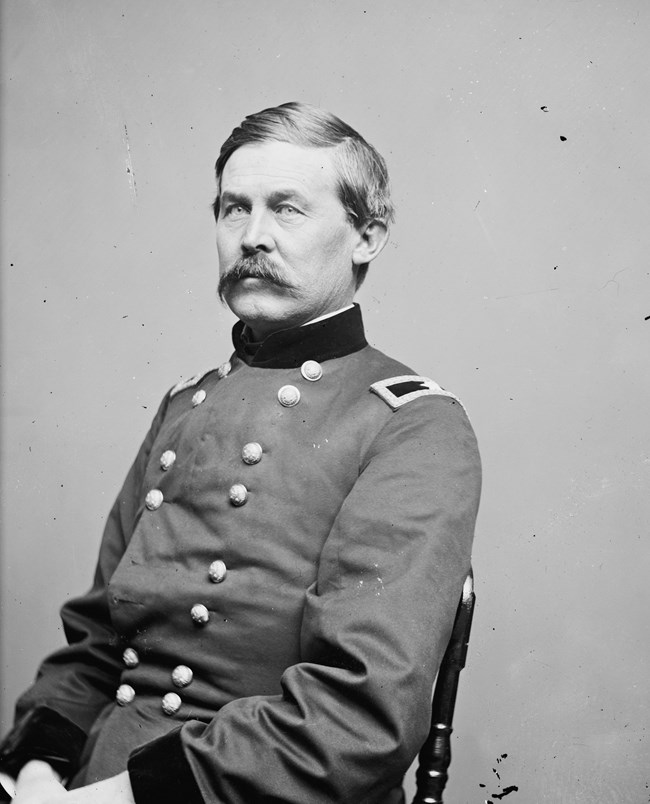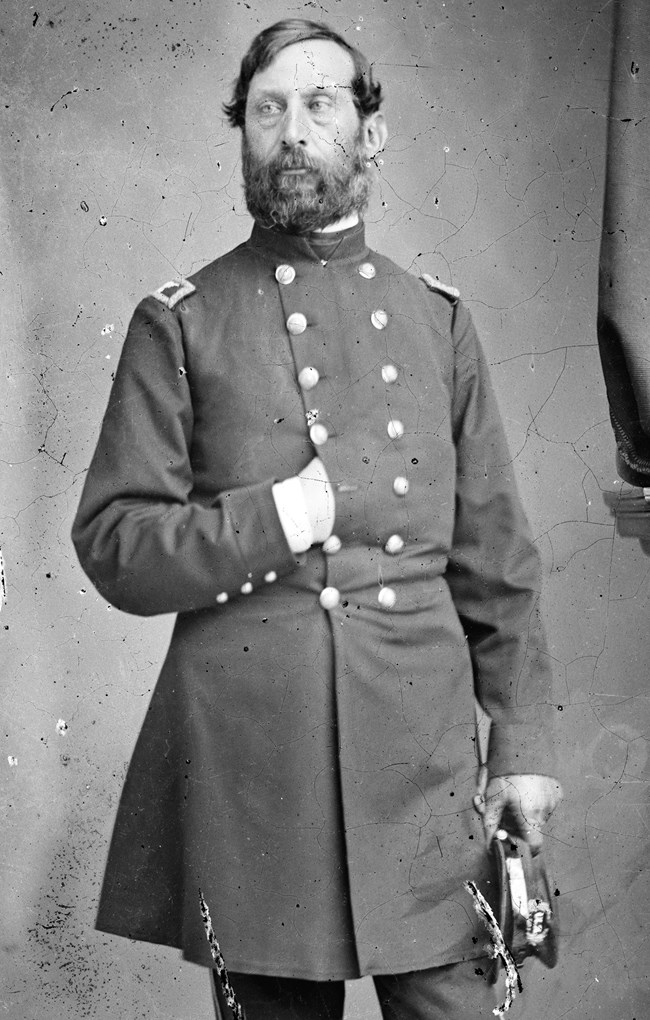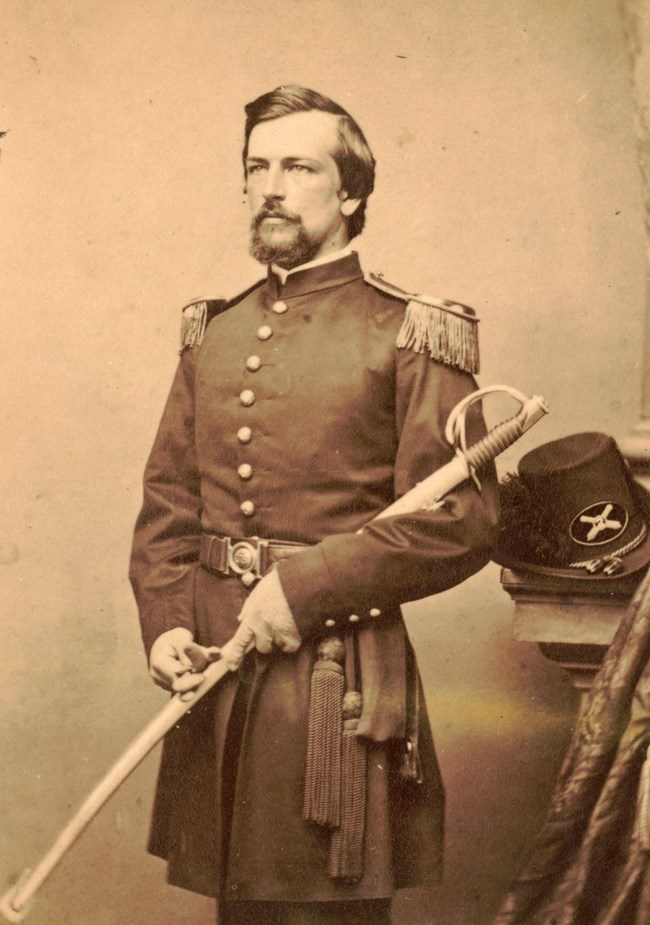Last updated: August 9, 2022
Article
Federal Commanders at Gettysburg

Library of Congress
John Buford
The commander of a cavalry division in the Army of the Potomac, General John Buford's troops encountered the head of a Confederate column on June 30 near Gettysburg. Buford decided to stay in the area overnight and wait for the Confederates to return the following day. His choice would set the stage for the Battle of Gettysburg that began the following day, July 1, 1863.
John Reynolds
One of the most highly respected and dynamic United States generals serving in the Army of the Potomac, General John Reynolds commanded the First Army Corps. Reynolds had previously declined an offer to command the army and recommended fellow Pennsylvanian, George Gordon Meade. Having rushed his infantry to the battlefield on July 1, Reynolds was encouraging his soldiers in a swift counterattack on Confederates in a grove of woods adjacent to the McPherson Farm when he was instantly killed. His loss from was sorely felt throughout the army.
Abner Doubleday
General Abner Doubleday, a New York officer, took command of the First Corps after the death of its leader, General Reynolds. He deployed his experienced troops on a line west of Seminary Ridge and held the ground until overwhelming numbers forced his depleted regiments to retreat through Gettysburg. After the war he authored Chancellorsville and Gettysburg, his memoir and history of the two great battles that were his last with the Army of the Potomac.
Winfield S. Hancock
General Winfield Hancock proved to be an outstanding field commander at Gettysburg. Meade sent Hancock as his representative to Gettysburg on July 1, where he took command of the chaotic situation. The Hancock personally followed the action on July 2 and played a prominent role in sending troops to threatened areas. He nearly lost his life while directing a counterattack against Pickett's Virginians on July 3rd, an injury that would plague him for the rest of his life.
Oliver Otis Howard
Commanding the Eleventh Corps, General Oliver Otis Howard took charge of the field after the death of Reynolds and secured Cemetery Hill as the final Federal position for which he later received a congressional thanks. Howard later served in the Atlanta Campaign with General Sherman and in 1867 worked to establish a school for African Americans in Washington, DC, known today as Howard University.

Library of Congress
Henry Hunt
In charge of the US artillery, General Henry Hunt’s disciplined use of Federal batteries played a major role in defeating the Confederate battle plans for July 2 and 3. Hunt's obsession with complete control of the army's artillery would conflict with infantry commanders at Gettysburg and elsewhere during the war.
Daniel Sickles
A colorful politician turned general, General Dan Sickles led his Thirds Corps to Gettysburg, determined not to allow the Confederates to hold higher ground. His controversial move forward from Cemetery Ridge on July 2nd resulted in the bloodiest day of fighting, costing the general most of his corps and a leg. Awarded the Medal of Honor for his services at Gettysburg, he sponsored the 1895 legislation that made the battlefield a national military park.
Gouverneur K. Warren
Serving as Meade's Chief of Engineers, General Gouverneur K. Warren was surveying the Federal left when he spied Confederate forces moving towards Little Round Top. Realizing its importance, he rushed troops to the hill's defense, which ultimately saved the US line on Cemetery Ridge. That evening, the exhausted Warren slept through Meade's Council of War. He later commanded the Fifth Corps in the Overland Campaign until a conflict with his superiors caused an abrupt end of his field command in 1865.
Joshua Chamberlain
A school teacher by trade, Joshua Chamberlain had risen to the rank of colonel of the 20th Maine Infantry by the summer of 1863. His battle tested veterans were pitched into a desperate fight with the 15th Alabama Infantry on July 2 and despite nearly overwhelming odds, won the day at Little Round Top thanks to their colonel's stubborn guidance. By war's end, Chamberlain was a major general and placed in charge of accepting the Confederate surrender parade at Appomattox Court House.
George A. Custer
Long before he would meet his fate at Little Big Horn, George Custer, as a newly appointed brigadier general, commanded a brigade of Michigan cavalry regiments. On July 3, 1863, he displayed his dynamic ability to lead men in battle, leading regiment after regiment in desperate charges that eventually won the day in the cavalry battle east of Gettysburg.
Alonzo Cushing
This 22 year-old West Pointer commanded Battery A, 4th United States Artillery. Though his battery was destroyed in the cannonade prior to Pickett's Charge, Cushing chose to remain on the field with his lone surviving cannon. He served against the Confederate infantry attack until shot dead at his post. "Faithful unto death", his fanatical devotion to duty helped turn the tide at Gettysburg. In 2010, the United States Army approved a request to award him the Congressional Medal of Honor.
Jonathan Letterman
As Medical Director of the Army of the Potomac, Dr. Jonathan Letterman’s skills at organization and support were unequaled. The task of treating countless wounded in and around Gettysburg was left up to his undermanned staff that worked diligently to save thousands of wounded United States and Confederate soldiers. Many convalesced at Camp Letterman, the general field hospital east of Gettysburg, before transfer to permanent hospitals elsewhere.

Library of Congress
Alexander S. Webb
A newly appointed brigadier general, Alexander Webb was placed in command of the Philadelphia Brigade during the march to Gettysburg. During Pickett's Charge on July 3, his troops met and threw back the Confederate breakthrough at the Angle. His dynamic leadership made a difference in the Federal defense even though he was so new to command that many of the soldiers in the brigade did not know who he was.
Frank A. Haskell
A Federal staff officer at Gettysburg, Lieutenant Haskell was a model soldier and disciplinarian who was in the center of the US line on July 2 and 3 where he witnessed most of the climactic events of the battle. He described his experiences in a lengthy letter to his brother that to this day is one of the most descriptive and eloquent battle narratives ever written. Haskell was killed at the Battle of Cold Harbor the following year.
